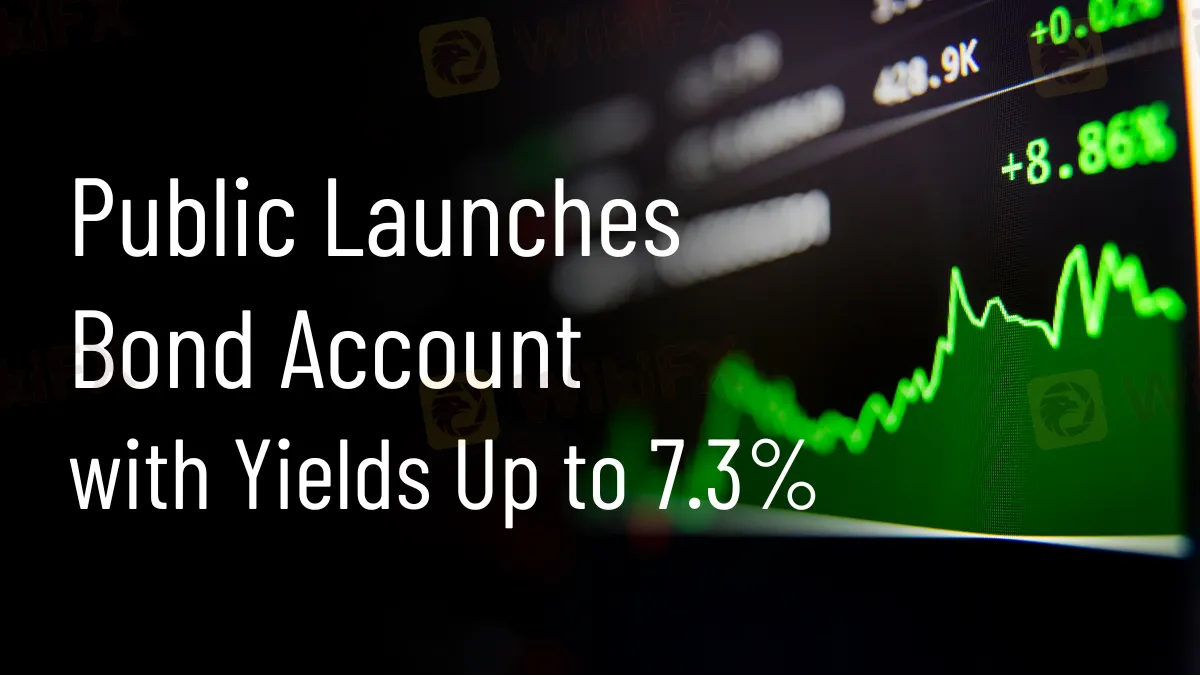简体中文
繁體中文
English
Pусский
日本語
ภาษาไทย
Tiếng Việt
Bahasa Indonesia
Español
हिन्दी
Filippiiniläinen
Français
Deutsch
Português
Türkçe
한국어
العربية
Public Launches Bond Account with Yields Up to 7.3%
Abstract:Public launches a new bond account offering yields up to 7.3%, providing an accessible way for investors to diversify their portfolios with corporate bonds.

Public, a popular New York-based investment platform, has launched a new bond account to enable customers to diversify their portfolios by investing in corporate bonds with returns as high as 7.3%. This current offering is attractively priced, providing yield-seeking investors with an excellent chance to earn long-term returns in a volatile market.
The Public Bond Account provides investors with access to a carefully selected selection of 10 corporate bonds from well-known corporations across a variety of sectors. These bonds provide yields ranging from 6% to 9%, enabling investors to diversify their portfolios without the hassle of choosing and buying bonds separately. This bond selection includes industry heavyweights such as Boeing, Tapestry, Warner Media LLC, Main Street Capital Corp, and Vornado Realty LP. This carefully chosen list is intended to help consumers diversify risk and optimize earnings.

Jannick Malling, Co-CEO and Co-Founder of Public stressed the urgency of this new product introduction. He said, “As rates potentially come down later this year and into next year, we are hearing from investors who want to lock in a higher yield now, and our Bond Account allows you to invest in the bond market in just a few clicks.” The debut of the Public Bond Account coincides with the Federal Reserve's predicted rate decreases in late 2024 or early 2025. As interest rates are forecast to fall, so will bond yields, making the present situation ideal for anyone wishing to invest in bonds for long-term returns.
The Public has made its bond account easily accessible and user-friendly. With a minimum investment requirement of just $1,000, Public makes bond investing more accessible to a larger audience than the $10,000 minimum demanded by other platforms. Furthermore, income received on the bonds is automatically reinvested once it exceeds $1,000, providing for smooth compounding of profits. Investors may also make recurrent contributions to expand their bond holdings.
This bond account is part of Public's larger objective of making various asset classes accessible to regular investors. In response to the success of their Treasury Account, Public continues to streamline the investment process, enabling users to efficiently diversify their portfolios. In May, fractional bond trading was also implemented by Public, which allows investors to purchase and sell corporate and Treasury bonds in smaller denominations, with a minimum investment of $100. This step demonstrates Public's commitment to democratizing access to the bond market.
Stay updated with the latest financial market news. Visit the WikiFX news page for more insights and updates.

Disclaimer:
The views in this article only represent the author's personal views, and do not constitute investment advice on this platform. This platform does not guarantee the accuracy, completeness and timeliness of the information in the article, and will not be liable for any loss caused by the use of or reliance on the information in the article.
Read more

Webull Launches SMSF Investment Platform with Zero Fees
Webull introduces commission-free SMSF trading, offering over 3,500 US and Australian ETFs, with no brokerage fees and enhanced portfolio tools.

Australian Authorities Joins Forces with Philippine Authorities to Combat Cyber Scams
AFP tackles cyber scam boiler rooms in the Philippines, training police to fight fraud and protect Australians from romance and cryptocurrency scams.

How Will the Market React at a Crucial Turning Point?
Safe-haven assets like gold and U.S. Treasuries are surging, while equities face mounting pressure. As this pivotal moment approaches, how will the market react?

Gold Prices Climb Again – Have Investors Seized the Opportunity?
Gold prices have hit record highs for three consecutive days, with a remarkable 19% gain in the first quarter, marking the strongest quarterly performance since 1986. As market risk aversion rises, demand for gold has surged significantly.
WikiFX Broker
Latest News
FCA Warns Against 10 Unlicensed or Clone Firms
CySEC Warns Against 14 Unlicensed Investment Websites
Top Currency Pairs to Watch for Profit This Week - March 31, 2025
Will natural disasters have an impact on the forex market?
Philippines Deports 29 Indonesians Linked to Online Scam Syndicate in Manila
Exposing the Top 5 Scam Brokers of March 2025: A Closer Look by WikiFX
Gold Prices Climb Again – Have Investors Seized the Opportunity?
Webull Launches SMSF Investment Platform with Zero Fees
Australian Regulator Warns of Money Laundering and Fraud Risks in Crypto ATMs
AI-Powered Strategies to Improve Profits in Forex Trading
Currency Calculator







